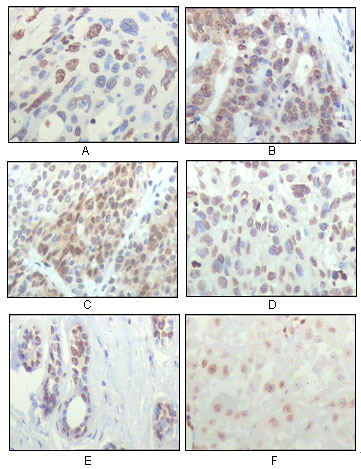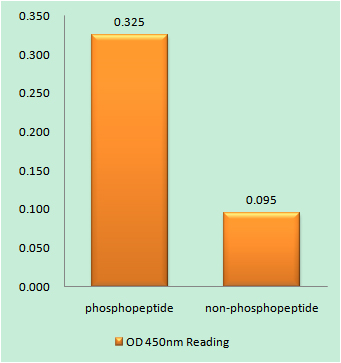Rsk-1 Monoclonal Antibody
- Catalog No.:YM0564
- Applications:WB;IHC;IF;ELISA
- Reactivity:Human
- Target:
- Rsk-1
- Fields:
- >>MAPK signaling pathway;>>Oocyte meiosis;>>mTOR signaling pathway;>>Thermogenesis;>>Long-term potentiation;>>Neurotrophin signaling pathway;>>Progesterone-mediated oocyte maturation;>>Insulin resistance;>>Yersinia infection;>>Chemical carcinogenesis - receptor activation
- Gene Name:
- RPS6KA1
- Protein Name:
- Ribosomal protein S6 kinase alpha-1
- Human Gene Id:
- 6195
- Human Swiss Prot No:
- Q15418
- Mouse Swiss Prot No:
- P18653
- Immunogen:
- Purified recombinant fragment of human Rsk-1 expressed in E. Coli.
- Specificity:
- Rsk-1 Monoclonal Antibody detects endogenous levels of Rsk-1 protein.
- Formulation:
- Liquid in PBS containing 50% glycerol, 0.5% BSA and 0.02% sodium azide.
- Source:
- Monoclonal, Mouse
- Dilution:
- WB 1:500 - 1:2000. IHC 1:200 - 1:1000. ELISA: 1:10000.. IF 1:50-200
- Purification:
- Affinity purification
- Storage Stability:
- -15°C to -25°C/1 year(Do not lower than -25°C)
- Other Name:
- RPS6KA1;MAPKAPK1A;RSK1;Ribosomal protein S6 kinase alpha-1;S6K-alpha-1;90 kDa ribosomal protein S6 kinase 1;p90-RSK 1;p90RSK1;p90S6K;MAP kinase-activated protein kinase 1a;MAPK-activated protein kinase 1a;MAPKAP kinase 1a;MAPKAP
- Molecular Weight(Da):
- 83kD
- References:
- 1. Alcorta, D.A., et al. 1989. Mol. Cell. Biol. 9:3850-3859.
2. Sweet, L.J., et al. 1990. Mol. Cell. Biol. 10: 2413-2417.
- Background:
- ribosomal protein S6 kinase A1(RPS6KA1) Homo sapiens This gene encodes a member of the RSK (ribosomal S6 kinase) family of serine/threonine kinases. This kinase contains 2 nonidentical kinase catalytic domains and phosphorylates various substrates, including members of the mitogen-activated kinase (MAPK) signalling pathway. The activity of this protein has been implicated in controlling cell growth and differentiation. Alternate transcriptional splice variants, encoding different isoforms, have been characterized. [provided by RefSeq, Jul 2008],
- Function:
- catalytic activity:ATP + a protein = ADP + a phosphoprotein.,caution:The sequence shown here is derived from an Ensembl automatic analysis pipeline and should be considered as preliminary data.,cofactor:Magnesium.,enzyme regulation:Activated by multiple phosphorylations on threonine and serine residues.,function:Serine/threonine kinase that may play a role in mediating the growth-factor and stress induced activation of the transcription factor CREB.,PTM:Autophosphorylated on Ser-380, as part of the activation process.,similarity:Belongs to the protein kinase superfamily.,similarity:Belongs to the protein kinase superfamily. AGC Ser/Thr protein kinase family. S6 kinase subfamily.,similarity:Contains 1 AGC-kinase C-terminal domain.,similarity:Contains 2 protein kinase domains.,subunit:Forms a complex with either ERK1 or ERK2 in quiescent cells. Transiently dissociates following mitogenic s
- Subcellular Location:
- Nucleus. Cytoplasm.
- Expression:
- Colon,Epithelium,
- June 19-2018
- WESTERN IMMUNOBLOTTING PROTOCOL
- June 19-2018
- IMMUNOHISTOCHEMISTRY-PARAFFIN PROTOCOL
- June 19-2018
- IMMUNOFLUORESCENCE PROTOCOL
- September 08-2020
- FLOW-CYTOMEYRT-PROTOCOL
- May 20-2022
- Cell-Based ELISA│解您多样本WB检测之困扰
- July 13-2018
- CELL-BASED-ELISA-PROTOCOL-FOR-ACETYL-PROTEIN
- July 13-2018
- CELL-BASED-ELISA-PROTOCOL-FOR-PHOSPHO-PROTEIN
- July 13-2018
- Antibody-FAQs
- Products Images

- Western Blot analysis using Rsk-1 Monoclonal Antibody against truncated Rsk-1 recombinant protein.

- Immunohistochemistry analysis of paraffin-embedded human esophageal squamous cell carcinoma (A), colon adenocarcinoma (B), liver carcinoma (C), skin carcinoma (D), breast ductal tumor (E) and brain tumor (F), showing nuclear localization with DAB staining


